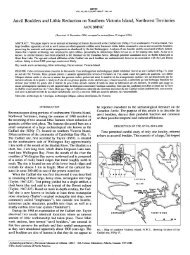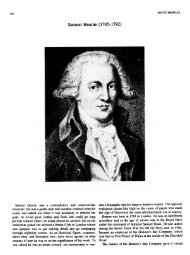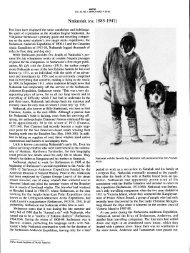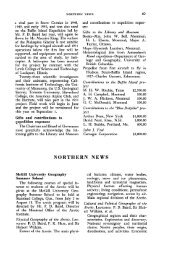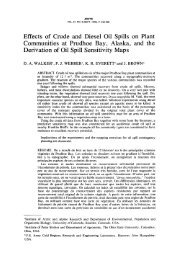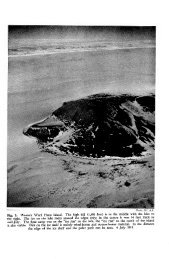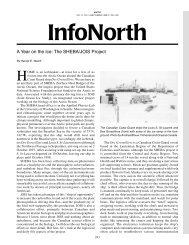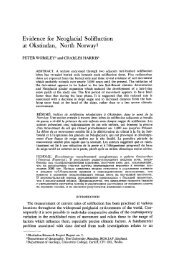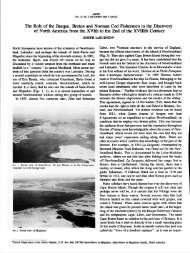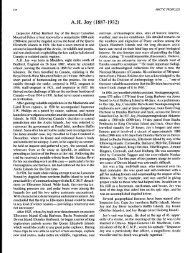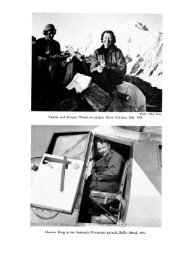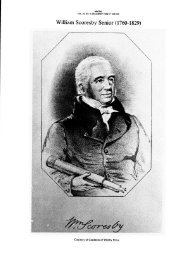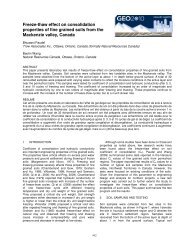To Make These Tribes Understand - AINA Publications Server
To Make These Tribes Understand - AINA Publications Server
To Make These Tribes Understand - AINA Publications Server
Create successful ePaper yourself
Turn your PDF publications into a flip-book with our unique Google optimized e-Paper software.
FIG. 2. Corporal W.A. Doak on patrol, 1921. National Archives of Canada, RCMP Collection, Access 1996-400, Neg. No. 880.<br />
I did not like it [this was women’s work]. One time he gave<br />
me seal skin long boots to fix the bottoms and I had done<br />
one when he told me that I had not done it right and for me<br />
not to fix the other boot. I was mad and did not feel good<br />
inside. The next day I think I like to kill that man. The<br />
morning after I worked on the boots I went to [the] Police<br />
store house and got Agnavik’s rifle … [Doak] was still<br />
asleep. … I shot him in the left buttock as I did not want<br />
to kill him right away as I wanted him to get mad. I wanted<br />
to wound him as there was [a] revolver beside his bed and<br />
I did not care if he shot me as I did not want to go west to<br />
Herschel Isl. … I did not want to go to a strange country.<br />
… I was afraid Binder would see Doak and want to kill me.<br />
… I shot to kill him. (CDSS, 1923)<br />
If this account is true, and there is no reason to suppose it<br />
is not, Doak showed very poor judgement in his treatment of<br />
Alikomiak, and it is difficult to know why he expressed<br />
impatience with the man, or gave him women’s work to do,<br />
given the fact that the earlier murder cases were well known<br />
by all members of the force—one would have thought that<br />
they would have been particularly careful to avoid the mistakes<br />
of Radford and Street, and the two Oblate fathers.<br />
Admittedly, however, Alikomiak seems to have been especially<br />
sensitive to perceived abuse, since he was never struck<br />
or even shouted at. This, at least, was the official version of<br />
events; a somewhat different story was given by the ethnographer<br />
Knud Rasmussen, who discussed the case a few years<br />
later with some Inuit from the region:<br />
Corporal Doak is described by all as a decent man; but he<br />
was in the habit [of] playing on the feelings of the accused<br />
Alekámiaq by assuming a brutal and terrifying manner,<br />
despite the fact that they could not speak to one another.<br />
According to what the other Eskimos told me, Alekámiaq<br />
INUIT TRIAL AT HERSCHEL ISLAND • 223<br />
by and by got the idea that Doak was going to kill him, so<br />
he decided to forestall him. (Rasmussen, 1932:63)<br />
In July 1923, Alikomiak and Tatamigana were tried at<br />
Herschel Island on a number of charges, along with three<br />
other Inuit charged with lesser offences (Fig. 4). There were<br />
four trials involving the two men; they were all brief by<br />
modern standards, for all were completed in a period of four<br />
days, which included one day wasted on a mistrial. Tatamigana<br />
was tried for killing a man named Hanak and wounding<br />
another man. They were both tried separately for the murder<br />
of another Inuk named Pugnana, and Alikomiak was tried for<br />
the murder of Doak and Binder.<br />
Sidney Harring, in his study of the case, remarks that these<br />
trials were “designed to legitimate some official policy, but<br />
were actually pre-decided” (Harring, 1989:7). In this instance,<br />
the official policy was at least as old as the Mounted<br />
Police themselves. The North-West Mounted Police were<br />
established by the government of John A. Macdonald in 1873<br />
in response to an atrocity that had occurred in what is now<br />
southwestern Saskatchewan, where a group of drunken wolfers<br />
from Montana had murdered more than twenty Indians. What<br />
alarmed Ottawa in this case was not so much the fate of the<br />
Indians, but the notice it gave to the world of the government’s<br />
powerlessness either to prevent such murders or to<br />
punish those who committed them. The North-West Mounted<br />
Police were founded to show the flag, to demonstrate Canada’s<br />
sovereignty over the newly acquired prairies. The<br />
Mounted Police have been described as a semimilitary organization,<br />
but they are more accurately described as being<br />
semipolitical (Morrison, 1985:3– 4). On the prairies they<br />
enforced Macdonald’s “national policy”—they made sure<br />
that settlement was peaceful and orderly, that the Native<br />
people moved to their reserves in a timely fashion, and that<br />
the Canadian Pacific Railway was not delayed by workers’



